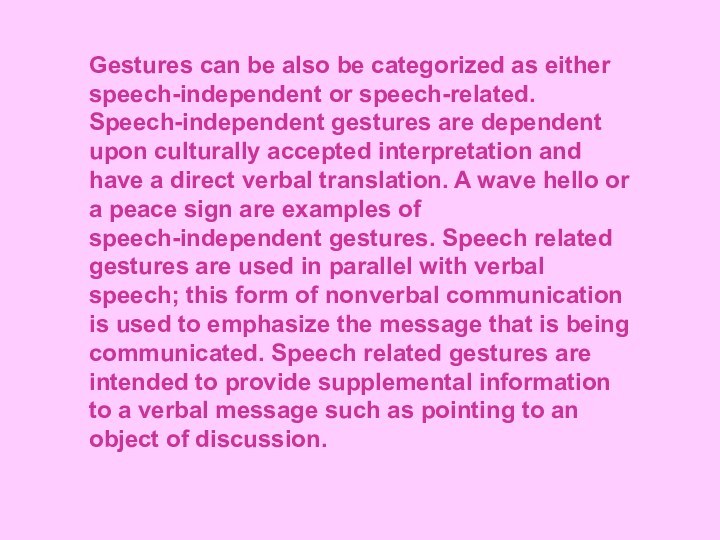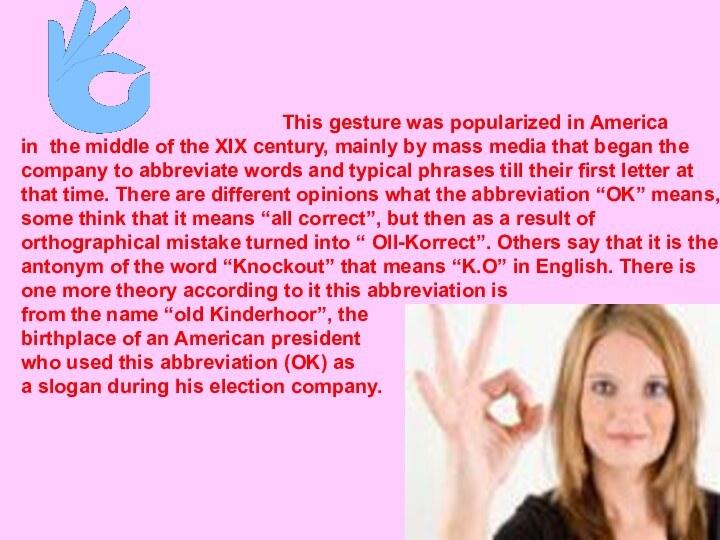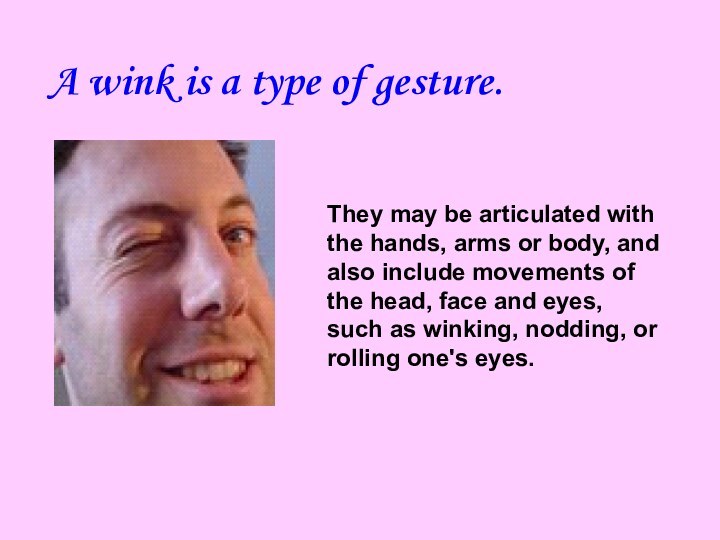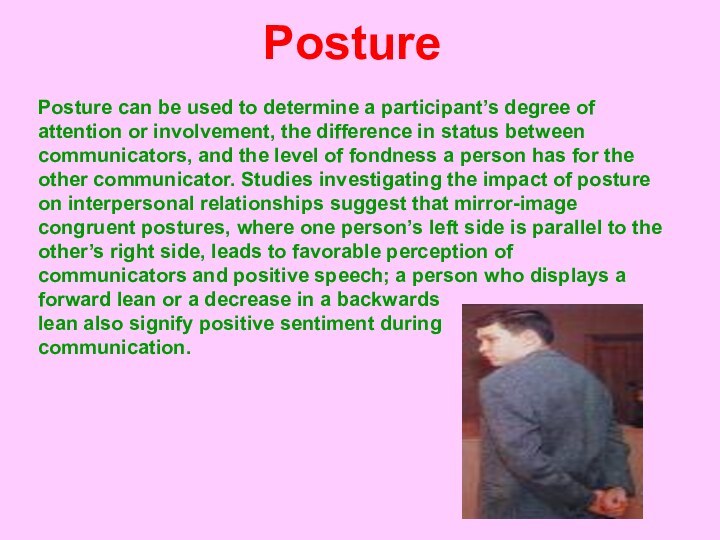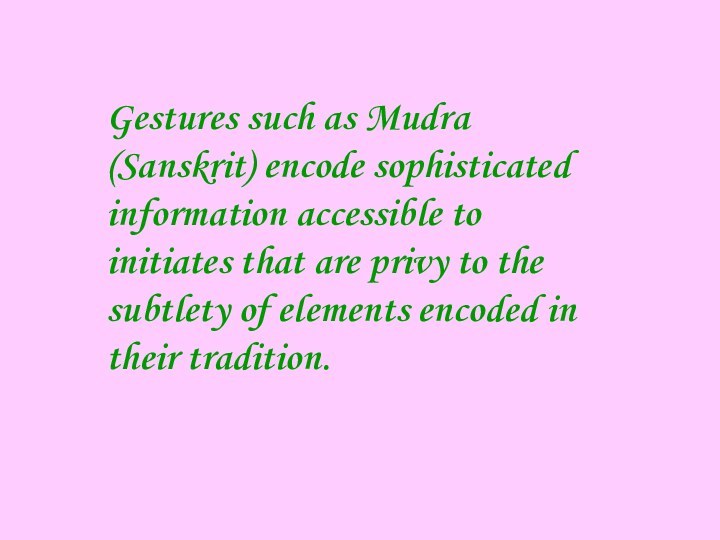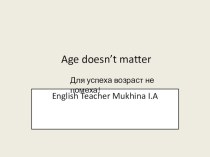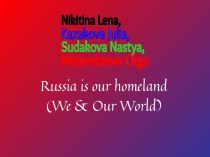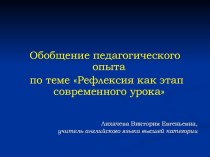Слайд 2
“Actions speak louder than words.”
Слайд 3
In essence, this underscores the importance of non-verbal
communication. Non-verbal communication is especially significant in intercultural situations.
Probably non-verbal differences account for typical difficulties in communicating.
The most basic form of communication is non-verbal. Anthropologists
theorize that long before human beings used words to talk things over, our
ancestors communicated with one another by using their bodies. They gritted
their teeth to show anger; they smiled and touched one another to indicate
affection. Although we have come a long way since those primitive times, we
still use non-verbal cues to express superiority, dependence, dislike,
respect, love, and other feelings.
Слайд 4
Non-verbal communication differs from verbal
communication in
fundamental ways. For one thing, it is
less structured, which makes it more
difficult to study. A person cannot pick up a book on non-verbal language
and master the vocabulary of gestures, expressions, and inflections that
are common in our culture.
Other types of non-verbal communication,
such as the meaning of colors
and certain gestures, vary
from culture to
culture.
Слайд 5
Definition “nonverbal communication involves those nonverbal stimuli in
a communication setting that are generated by both the
source (speaker) and his or her use of the environment and that have potential message value for the source or receiver (listener). It includes — but is not limited to:
touch
glance
eye contact (gaze)
volume
vocal nuance
proximity
gestures
intonation
dress
posture
smell
word choice and syntax
sounds (paralanguage)
Слайд 6
Gesture
A gesture is a non-vocal bodily movement
intended to express meaning. The boundary between language and
gesture, or verbal and nonverbal communication, can be hard to identify.
Слайд 7
Gestures can be also be categorized as either
speech-independent or speech-related. Speech-independent gestures are dependent upon culturally
accepted interpretation and have a direct verbal translation. A wave hello or a peace sign are examples of speech-independent gestures. Speech related gestures are used in parallel with verbal speech; this form of nonverbal communication is used to emphasize the message that is being communicated. Speech related gestures are intended to provide supplemental information to a verbal message such as pointing to an object of discussion.
Слайд 8
When going on a journey we try to
know as much as possible about the place of
our destination. We look through weather forecasts, political news, take a phrase book. But having been ready we are disconcerted when our gestures are not understood.
One and the same gestures are different in different cultures.
Слайд 9
Both languages differ from each other according to
types of culture, and nonverbal language of one nation
differs from another one. When a gesture can be common and have a clear interpretation with one with another one. For example let's see the difference
in interpretation of
the three typical
gestures,
such as the circle
of fingers, raised
the thumb up and
V-gesture
of fingers.
Слайд 10
Non verbal communication gestures.
1. If your interlocutor
drums with fingers it can mean that he shows
impatience to what is dull or he is nervous.
2. If you interlocutors shrugs his shoulders, it can mean that he is not interested in what you are telling him.
3. If he squeezes his hands it can mean despair and the feeling of hopeless.
4. If your interlocutor squeezes his fists it means that he is aggressive and tries to control his anger.
5. If his hands are weak and he turns his palms up holding them in front of him it means he is surprised, perplexed and is at a loss.
6. If he unbuttons the jacket it means that he is ready for active actions.
7. The hand crossed on his chest mean challenge, blame.
8. If a man goes quickly and his hands hang freely the chin is raised up it mean he shows his resolution and confidence.
9. If he goes, dragging his hand with hands in pockets his head is down it means that he is in low spirit, in despair in depression.
Слайд 11
10. The palm on the check mean interest

on … verge of surprise.
11. If you interlocutor beats
himself in the chin it means that a guess came into his mind, he is worried.
12. If a man touches and rubs his nose it means he thinks about something.
13. If he stand in the pose “hand on hips” it can mean confidence, superiority and challenge.
14. If palms are put as a house it means that he thinks and shows his interest.
15. If you interlocutor beats his head aside it means he plays fool or can make fun.
16. If you interlocutor moves his glasses down a look above the rims perhaps he wants more … especially facts.
17. If a man goes forward and back ward he seems to be nervous and anxious.
18. If a man presses his bridge of the nose he is tired (it his glassed don't press on him).
19. If a man sit at the edge of the chair it means he waits or shows his interest.
20. If a man sits “leg on leg” and shaking his leg he is most probably bored.
21. If a man makes a gesture with a tore finger he most probably wants to underline his point of view.
22. If a man leans back and holds himself his neck with the help of crossed hands it means that he tries to relax or make a good impression.
23.
24. If a man closed his mouth with his hand he doesn't want to be understood.
25. If а man moved his hand behind hid back and squeezes it in a fist and the other hand holds it on the wrist he is reserved and tense.
This gesture was popularized in America in the middle of the XIX century, mainly by mass media that began the company to abbreviate words and typical phrases till their first letter at that time. There are different opinions what the abbreviation “OK” means, some think that it means “all correct”, but then as a result of orthographical mistake turned into “ Oll-Korrect”. Others say that it is the antonym of the word “Knockout” that means “K.O” in English. There is one more theory according to it this abbreviation is
from the name “old Kinderhoor”, the
birthplace of an American president
who used this abbreviation (OK) as
a slogan during his election company.
Слайд 15
The raised up thumb in America, England and
has three meanings. It is usually used when you
want to catch a passing car. The second meaning is “everything is all right”.
The gesture with raising the thumb together with other gestures is used as a symbol of power a superiority as well as in the situations when somebody wants to “crush you with the thumb”.
Слайд 17
This sign is very popular in Britain an
outrageous interpretation.
During World war II Winston Churchill popularized
this sign to mean victory, but the hand is turned with arear side to the speaker. If according to this gesture the hand is turned by the palm to the speaker this gesture has an outrageous meaning “shut up”. However V-gesture in any case means “victory” in many countries in England. But in many countries this sign also means
the figure “2”.
Слайд 18
To greet and to say good-by are different
in USA.
Слайд 19
The main communicative gestures all over the world
don't doffer from each other. When people are happy,
they smile, when they are sad – they frown, when they are angry – they have angry look Nodding all over the world means “yes”, or agreement. Waving your head to mean “no” or disagreement is also universal and can be one of the gestures, invented in childhood. When a child has sucked milk he pushes mother's breast and moves his head from one side to another. When a baby has eaten, he rolls his head from one side to another to escape from the spoon, that his parents feed him with. So he is quickly used to nod to show his disagreement or negative attitude.
The main communicative gestures and their origin.
Слайд 20
They may be articulated with the hands, arms
or body, and also include movements of the head,
face and eyes, such as winking, nodding, or rolling one's eyes.
A wink is a type of gesture.
Слайд 21
Eye Contact and Gaze
In USA, eye contact indicates:
degree of attention or interest, influences attitude change or
persuasion, regulates interaction, communicates emotion, defines power and status, and has a central role in managing impressions of others.
Within USA, African-Americans use more eye contact when talking and less when listening with reverse true for Anglo Americans. This is a possible cause for some sense of unease between races in US. A prolonged gaze is often seen as a sign of sexual interest.
Haptics is the study of touching as nonverbal communication.
These behaviors are referred to as "adaptor" and may send messages that reveal the intentions or
feelings of a communicator. The meaning
conveyed from touch is highly dependent
upon the context of the situation, the
relationship between communicators,
and the manner of touch.
Слайд 23
Touches that can be defined as communication
include handshakes, holding hands, kissing (cheek, lips, hand),
back slapping, high fives, a pat on the shoulder, and brushing an arm. Touching of oneself during communication may include licking, picking, holding, and scratching.
Touches
Posture can be used to determine a participant’s degree of attention or involvement, the difference in status between communicators, and the level of fondness a person has for the other communicator. Studies investigating the impact of posture on interpersonal relationships suggest that mirror-image congruent postures, where one person’s left side is parallel to the other’s right side, leads to favorable perception of communicators and positive speech; a person who displays a forward lean or a decrease in a backwards
lean also signify positive sentiment during
communication.
Слайд 25
Posture is understood through such
indicators
as direction
of lean, body
orientation, arm
position, and body openness
Movement and body position
Слайд 26
Smile
Smile is the only way to gain a
partner, it is used and perceived well in any
country and in any culture.
Smiling is the most effective form of relations and finally the best compliment we can do for our interlocutor will be true interest to him and his problems. When going to other countries don't forget your smiles.






